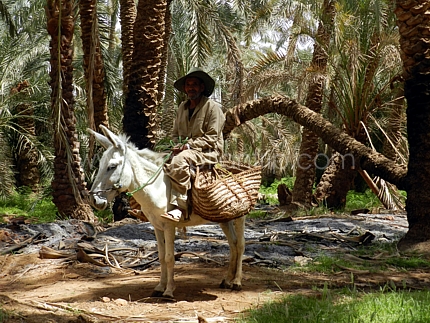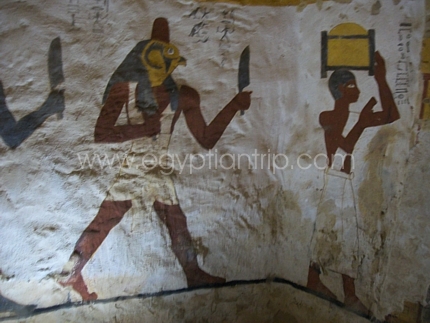
|
| El-Wahat el-Bahariya or Bahariya Oasis is the northernmost oasis of Egypt. This oasis has a particular historical significance as it was an important transit point for the Caravan tracks and the Nile Valley.
Bahariya is located 360 kilometers to the North of Cairo, Located in Giza Governorate, the main economic sectors are agriculture, iron ore mining, and tourism. The main agricultural products are guavas, which made it nearer to the capital of Egypt in comparison to other remote oasis like Siwa or Al Kharga. This is maybe why many Carians and tourists who visit Cairo prefer to travel to the Bahariya if they want to try the taste of the lifestyle in an Egyptian oasis.
The Bahariya consists of a large depression in the desert that is 94 kilometers long and 40 kilometers wide. The oasis also contains a number of huge mountains like Gebel Ghurabi, Gebel Maghrafa, Gebel Dist, or Gebel El Englizi, or the English Mountain.
The main economic sectors are agriculture, iron ore mining, and tourism. The main agricultural products are guavas, mangos, dates, and olives.The name of the Bahariya Oasis. The name Bahareya was most possibly derived from the word Bahr, which means the sea in the Arabic language. The word more specifically referred to the Mediterranean Sea and generally to the Northern lands of Egypt in ancient times. The pharos named the Bahareya Oasis "Desdes" while the romans named it "Parva" or the little oasis. The History of the Bahariya Oasis The depression was populated since the neolithic, even if there is no archaeological evidence to all times. In el-Haiz, a prehistoric settlement site of hunter-gatherers was found with remains of grindstones, arrowheads, scrapers, chisels, and ostrich eggshells. In Qārat el-Abyaḍ, a Czech team led by Miroslav Bárta discovered a settlement of the Old Kingdom. Rock inscriptions in el-Harrah and other records date to the Middle Kingdom and upwards. The tomb of Amenhotep called Huy was erected in Qarat Hilwah at the end of the 18th dynasty. In the 26th dynasty, the depression was culturally and economically flourishing. This can be learned from the chapels in 'Ain el-Muftilla, the tombs in Qārat Qasr Salim and Qarat esh-Sheikh Subi, and the site of Qasr 'Allam. A newly flourishing time occurs at the Greek-Roman time. There is the ruin of a temple to Alexander the Great located in Qasr el-Miqisba ('Ain et-Tibniya). It is believed by some Egyptologists that the Greek conqueror passed through Bahariya while returning from the oracle of Ammon at Siwa Oasis. Excavations of the Greco-Roman necropolis found in 1995 and known as the Valley of the Golden Mummies began in 1999. Approximately thirty-four tombs have been excavated from this area. In Roman times, a big military fort was erected at Qarat el-Toub. In the spring of 2010, a Roman-era mummy was unearthed in a Bahariya Oasis cemetery in el-Harrah. The 3-foot-tall female mummy was found covered with plaster decorated to resemble Roman dress and jewelry. In addition to the female mummy, archaeologists found clay and glass vessels, coins, anthropoid masks and 14 Greco-Roman tombs. Director of Cairo and Giza Antiquities Mahmoud Affifi, the archaeologist who led the dig, said the tomb has a unique design with stairways and corridors, and could date to 300 BC. This find came as a result of excavation work for the construction of a youth center. Carcharodontosaurus and Bahariasaurus (meaning "Bahariya lizard") dinosaur found in the Bahariya Formation, which date to about 95 million years ago. It was a huge theropod, it was described by Ernst Stromer in 1934,[13] though the type specimen was destroyed during World War II in 1944. In 2000, an American scientific team conducted by Joshua Smith found the remains of type of dinosaur, the Paralititan stromer. People and Culture The people of the oasis, or the Waḥātī people (meaning "of the oasis" in Arabic), are the descendants of the ancient people who inhabited the oasis, Bedouin tribes from Libya and the north coast, and other people from the Nile Valley who came to settle in the oasis. The majority of Waḥātī people in Bahariya are Muslims. There are some mosques in Bahariya. The nature of social settings in the oasis is highly influenced by Islam. Also, traditional music is very important to the Waḥātī people. Flutes, drums, and the simsimeyya (a harp-like instrument) are played at social gatherings, particularly at weddings. Traditional songs sung in rural style are passed down from generation to generation, and new songs are invented as well. Music from Cairo, the greater Middle East, and other parts of the world are now easily accessible to the people of the oasis. Modernity (Bahariya today) The oasis has changed drastically in the past 30 years after an asphalt road connecting Bahariya to Cairo was finished in the early 70s. With the new road came electricity, cars, television, phone lines, and a more accessible route to Cairo. The spread of people and ideas between Bahariya and Cairo has increased dramatically since the road was constructed. Also, the language of the Waḥātī people has been changed and influenced in new ways as the Cairene dialect is heard on television and in music. The Bahareya Oasis hosts more than thirty thousand people who mostly live in the four main towns of the oasis: Bawiti, the capital and center point of the Bahareya Oasis, Al Qaser, the ancient village in the Bahareya Oasis, Mandisha, and Zabw. The area between Bawiti and Al Qaser contains a number of mountains that host many ancient necropolises like the Abis necropolis of Qarat Feragi and the Necropolis of Qarat Subi. The Bahareya Oasis has many hot springs like Ain Bishmu which dates back to Roman times, Bir Al Nebaga which is located in Bawiti, and Bir Matar which is located further to the North. At the Northernmost point of the Bahareya Oasis, there is the small lake of Al Marun that is surrounded by places that have many rare birds for bird watching fans. What to See in Bahariya Oasis ? Natural Places 1- Mountains ( Jebal) In 1996, the famous Egyptian archeologist and the head of the supreme council of antiquities, Mr. Zahi Hawas and his team, discovered a magnificent huge necropolis that dates to the Roman era and it is located 6 kilometers to the Southwest of Bawiti, the largest city of the Bahareya Oasis The digging work started in 1999 and it showed that this necropolis was the most important burial site of the Romans in all the land of Egypt. This necropolis, in fact contains hundreds of tombs over a surface area of about 36 square kilometers. This astonishing discovery which news were spread all over the world in TV channels, newspapers, magazines, and over the internet, made Al Bahareya Oasis famous world wide and gave the oasis a new touristic dimension Tens of mummies were discovered in perfect preservation state in the valley of the golden mummies. Most of these mummies were mummified using the old method which is called cartonnage. This method consisted of covering the face of the mummy with mask made out of linen and plaster. This mask was then decorated with many colorful reliefs. The mouse and the eyes of the dead person were then painted on the mask to give a clearer image of his face. The mummies of the Bahareya Oasis had the common Roman decoration of the Roman period that combined the traditional ancient Egyptian Pharonic shapes and colors with those of the Roman mythology. The valley of the golden mummies in the Bahareya Oasis is one of the most unique necropolises all around Egypt 2- The Temple and chapels of Ain el Muftella. The temple is 3 km west of town, built in the 26th Dynasty during the reigns of kings Apries and Ahmose II. The sandstone temple has four ruined chapels covered by a new roof. They are decorated with scenes depicting the king presenting offerings to 18 different gods. The reliefs are sunken and painted. One of the temples is dedicated to the god of musicians and dancers, Bes. 3- The Tombs of Nobles (Qaret Qasr Salim ) This small hill in Bawati contains 2 tombs from the 26th Dynasty. The tomb of Banentiu A wealthy merchant, has a steep descent to a hypostyle hall. The 4 square columns are painted with deities and the ceiling has a fantastic winged sun-disk. The walls by the entrance show the journeys of the moon and the sun. The colours used are rich, earthy ochres and reds. The tomb of Zed-Amun-ef-Ankh, his father, has very colourful pictures of the gods carrying out the mortuary rituals. It is thought that he was also a wealthy wine trader or local landowner. The ceiling is painted with a starry sky containing the image of a vulture. |
        |
4- The Bahareya Museum. Also known as Bawati Museum or the Mummy Hall, the museum contains discoveries from a vast cache of mummies found in Bahariya. The Greco-Roman mummies were found by chance when a donkey stumbled into a hole in the desert in 1996. The necropolis beneath was vast and it is believed there are over 10,000 mummies buried there. Many were beautifully decorated, some covered with a layer of gold, some wearing painted masks and jewellery, some buried in pottery coffins and some wrapped in linen. They were surrounded by amulets, coins and wine jars needed for their afterlife. Among the 10 mummies on display in the museum are 4 of the famous Golden Mummies, which are a life-like representation of the deceased with curly hair and long eyelashes. Excavation of the Valley of the Golden Mummies has been suspended because the mummies deteriorate and decompose when they are taken out of the ground. 5- The temple of Alexander the great. Alexander's temple is about 5 km east of Bawati, near the Valley of the Golden Mummies. It was built after Alexander the Great visited Bahariya in 332 BC on his way to consult the Oracle of Amun in Siwa. The sandstone temple is surrounded by 45  mud-brick rooms, where the priests lived and goods were stored. A 1-m high red granite altar was erected south of the entrance, inscribed with Alexander's name and now in the Egyptian Museum in Cairo. In the inner sanctuary Alexander and the mayor who built the temple are shown in bas-relief making offerings to Amun-Re and other gods. The reliefs have unfortunately been greatly damaged by desert winds since they were first discovered.6- The ruins of the English House. mud-brick rooms, where the priests lived and goods were stored. A 1-m high red granite altar was erected south of the entrance, inscribed with Alexander's name and now in the Egyptian Museum in Cairo. In the inner sanctuary Alexander and the mayor who built the temple are shown in bas-relief making offerings to Amun-Re and other gods. The reliefs have unfortunately been greatly damaged by desert winds since they were first discovered.6- The ruins of the English House.6- Al-Hez Farther away, 40 km southwest, from Bawati are the small villages of Al-Hez. There are 4 important springs here, prehistoric artefacts, and the remains of Roman aqueducts. Most interesting is the only well-preserved church in the Western Desert, near the hamlet of Ain Al-Ris. It was dedicated to St George and still has paintings on the inside of the mud-brick walls. Other Roman remains include Qasr Masuda, a large multi-storied fortress that had 13 rooms. | |
|